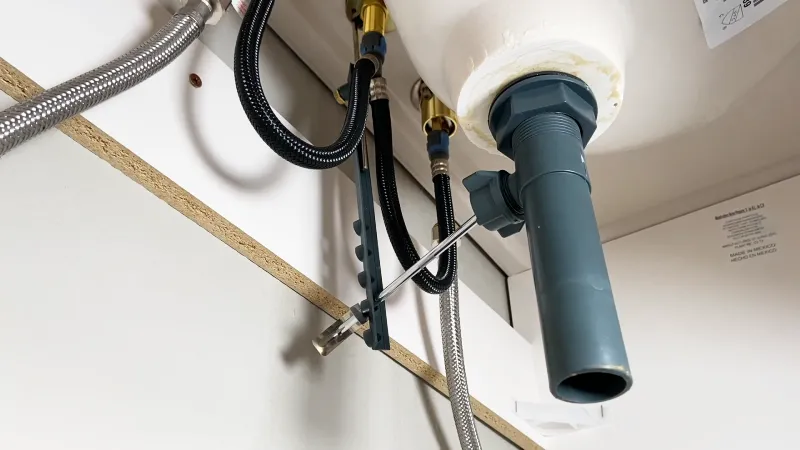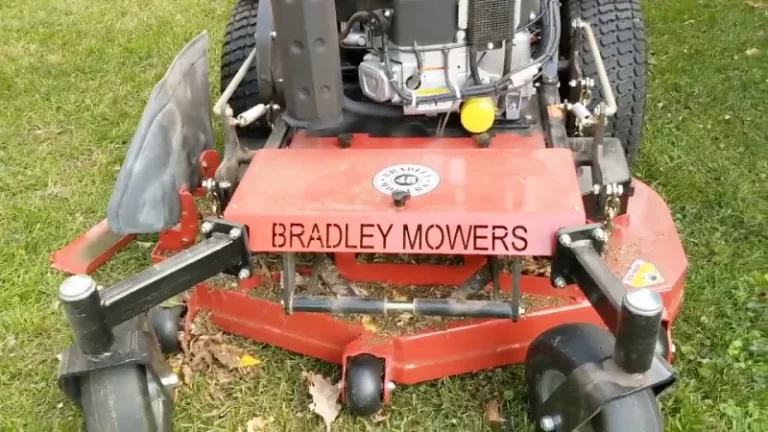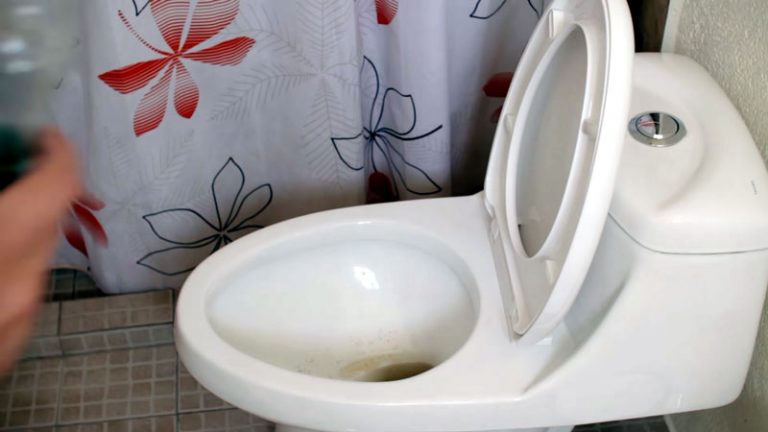Why is My Bathroom Sink Leaking At Wall Connection?

If you’ve ever experienced a bathroom sink leak, you know how frustrating and damaging it can be. A leak at the wall connection is a particularly common issue, and it can be caused by a variety of factors.
Whether it’s a loose slip-joint nut, corrosion on the nipple coming out of the wall, or damaged or worn parts, addressing the issue as soon as possible is important to prevent further damage to your bathroom and home.
In this article, we’ll explore the potential causes of a bathroom sink leaking at the wall connection and provide step-by-step solutions for fixing the issue.
You'll Learn About
Causes Of A Bathroom Sink Leaking At The Wall Connection
There are several potential causes of a bathroom sink leaking at the wall connection.
- One of the most common causes is a loose slip-joint nut. The slip-joint nut is what connects the “P” trap to the wall, and if it is not tightened securely, it can cause a leak.
- Another potential cause is corrosion on the nipple coming out of the wall. If there is a lot of corrosion on the nipple, it can weaken the connection and cause a leak.
- Damaged or worn parts such as the slip-joint washer or the “P” trap itself can also cause a leak at the wall connection. It is important to identify the cause of the leak in order to determine the most effective solution.
Solution: Tightening The Slip-Joint Nut
If you suspect that a loose slip-joint nut is causing the leak at the wall connection of your bathroom sink, you can try tightening it to see if this resolves the issue. Here are the steps to follow:
- First, turn off the water supply to your bathroom sink. This will prevent any water from flowing while you work on the connection.
- Next, locate the slip-joint nut that connects the “p” trap to the wall. This will be located underneath the sink.
- Use slip-joint pliers or an adjustable wrench to tighten the slip-joint nut. Make sure to turn the nut clockwise to tighten it.
- Once the nut is tightened, turn the water supply back on and check for leaks. If the leak persists, you may need to try a different solution.
Here are a few tips for ensuring a secure connection when tightening the slip-joint nut:
Use A New Slip-Joint Washer
The slip-joint washer is a small, white rubber ring that goes inside the nut. If the washer is old or damaged, it may not create a secure seal. Consider replacing the washer to ensure a tight connection.
Clean The Threads
Make sure that the threads on the “P” trap and the wall are clean and free of debris. This will help ensure that the nut can be tightened securely.
Use Penetrating Oil
If the threads are corroded or stuck, you may need to use penetrating oil to loosen them up. This will allow you to easily tighten the nut.
Don’t Overtighten
It’s important to tighten the nut securely, but be careful not to overtighten it. This could strip the threads or cause the nut to crack, which could lead to further issues.
Solution: Replacing The Slip-Joint Washer
If tightening the slip-joint nut doesn’t fix the leak at the wall connection of your bathroom sink, you may need to consider replacing the slip-joint washer. Here’s how to identify if the washer is the cause of the leak and how to replace it:
Identify The Cause Of The Leak
If the leak is coming from the area where the “P” trap connects to the wall, the washer is a likely suspect. You can check the condition of the washer by removing the slip-joint nut and examining the washer. If the washer is old, damaged, or deformed, it may be causing the leak.
Turn Off The Water Supply
To replace the washer, you’ll need to turn off the water supply to the bathroom sink. This will prevent any water from flowing while you work on the connection.
Remove the slip-joint nut
Use slip-joint pliers or adjustable wrenches to loosen and remove the slip-joint nut that connects the “P” trap to the wall.
Remove The Old Washer
Once the nut is removed, you’ll be able to access the old washer. Carefully remove the old washer from the nut.
Install the new washer
Place the new washer inside the nut and ensure it is seated properly.
Reassemble The Connection
Place the nut back on the “P” trap and use the slip-joint pliers or adjustable wrench to tighten it securely. Make sure to turn the nut clockwise to tighten it.
Turn The Water Supply Back On
Once the connection is reassembled, turn the water supply back on and check for leaks. If the leak persists, you may need to try a different solution.
Replacing the slip-joint washer is a relatively simple task that can often fix a leak at the wall connection of a bathroom sink. Make sure to use a new washer to ensure a secure connection.
Solution: Replacing The Nipple
If you’ve tried tightening the slip-joint nut and replacing the slip-joint washer, but the leak at the wall connection of your bathroom sink persists, you may need to consider replacing the nipple. The nipple is the part of the connection that extends from the wall to the “P” trap.
Here’s how to identify if the nipple is the cause of the leak and how to replace it:
Identify The Cause Of The Leak
If the leak is coming from the area where the “P” trap connects to the wall, the nipple is a likely suspect. You can check the condition of the nipple by removing the slip-joint nut and examining the nipple. If the nipple is severely corroded or damaged, it may be causing the leak.
Turn Off The Water Supply
To replace the nipple, you’ll need to turn off the water supply to the bathroom sink. This will prevent any water from flowing while you work on the connection.
Remove the slip-joint nut
Use slip-joint pliers or an adjustable wrench to loosen and remove the slip-joint nut that connects the “P” trap to the wall.
Disconnect The “P” Trap
Once the nut is removed, you’ll be able to access the “P” trap. Carefully disconnect the “P” trap from the nipple by loosening the compression nut that holds it in place.
Remove The Old Nipple
Once the “P” trap is disconnected, you’ll be able to access the old nipple. Carefully remove the old nipple from the wall.
Install the new nipple: Place the new nipple in the wall and make sure it is seated properly.
Reassemble The Connection
Connect the “P” trap to the new nipple using the compression nut. Tighten the nut securely to ensure a secure connection.
Reinstall The Slip-Joint Nut
Place the slip-joint nut back on the “P” trap and use the slip-joint pliers or adjustable wrench to tighten it securely. Make sure to turn the nut clockwise to tighten it.
Turn The Water Supply Back On
Once the connection is reassembled, turn the water supply back on and check for any leaks. If the leak persists, you may need to consult a professional plumber for further assistance.
Replacing the nipple can be a more involved process, but it is often necessary to fix a leak at the wall connection of a bathroom sink. Make sure to use a new nipple to ensure a secure connection.
Solution: Replacing Other Damaged Or Worn Parts
If you’ve tried tightening the slip-joint nut, replacing the slip-joint washer, and replacing the nipple, but the leak at the wall connection of your bathroom sink persists, you may need to consider replacing other damaged or worn parts.
The “P” trap is one of the parts that are most likely to cause a leak if it is damaged or worn. Here’s how to identify if other parts, such as the “P” trap, are causing the leak and how to replace them:
Identify The Cause Of The Leak
If the leak is coming from the area where the “P” trap connects to the wall, the “P” trap or another part may be the cause. You can check the condition of the “P” trap and other parts by removing the slip-joint nut and examining them. If the “P” trap or another part is damaged or worn, it may be causing the leak.
Turn Off The Water Supply
To replace any parts, you’ll need to turn off the water supply to the bathroom sink. This will prevent any water from flowing while you work on the connection.
Remove the slip-joint nut
Use slip-joint pliers or an adjustable wrench to loosen and remove the slip-joint nut that connects the “P” trap to the wall.
Disconnect The “P” Trap
Once the nut is removed, you’ll be able to access the “P” trap. Carefully disconnect the “P” trap from the nipple by loosening the compression nut that holds it in place.
Remove The Old Part
Once the “P” trap is disconnected, you’ll be able to access any other damaged or worn parts. Carefully remove the old part from the connection.
Install the new part
Place the new part in the connection and make sure it is seated properly.
Reassemble The Connection
Connect the “P” trap to the nipple using the compression nut. Tighten the nut securely to ensure a secure connection.
Reinstall The Slip-Joint Nut
Place the slip-joint nut back on the “P” trap and use the slip-joint pliers or adjustable wrench to tighten it securely. Make sure to turn the nut clockwise to tighten it.
Turn The Water Supply Back On
Once the connection is reassembled, turn the water supply back on and check for leaks. If the leak persists, you may need to consult a professional plumber for further assistance.
Replacing damaged or worn parts can be a more involved process, but it is often necessary to fix a leak at the wall connection of a bathroom sink. Make sure to use new parts to ensure a secure connection.
Final Words
A leaking bathroom sink at the wall connection can be caused by a variety of factors such as a loose slip-joint nut, corrosion on the nipple, damaged or worn parts, and more. It is important to identify the specific cause of the leak in order to properly address and fix the issue.
If you are unsure of the cause, it is best to consult with a professional plumber for assistance.



